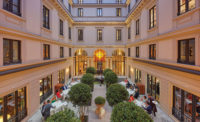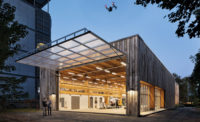The School by Antonio Jiménez Torrecillas
Kinderhook, New York
























It looked like a graduation. On a Saturday afternoon, a crowd of people gathered around a small stage set up on the lawn in front of the Martin van Buren School, a sturdy Colonial Revival building in Kinderhook, New York. But rather than students in caps and gowns, a small parade of people beating out pseudo-African rhythms on hand drums proceeded up onto the stage. Next came a group of writhing dancers in gold masks and neon fur suits, and, finally, duos of performers inside colorful horse costumes. The audience, a mix of locals and a Manhattan art crowd who made the two-hour journey up the Hudson River, applauded the performance, which was organized by Chicago artist Nick Cave. Off to one side, art dealer Jack Shainman was beaming.
Additional Content:
Jump to credits & specifications
Torrecillas and his firm worked with Carlos Vega, an artist and Shainman’s business partner, to reconfigure the school’s plan, tailoring its interiors to suit the gallery’s roster of artists and the various scales and materials of their work. To host large sculptures and installations, the designers inserted a rectangular 5,000-square-foot gallery with a 24-foot-high ceiling into the heart of the building, carving the space out of the basement and ground floor and reorganizing the school’s warren of rooms around it. From a restored entry—updated with white walls and uplighting above the moulding—visitors move through a series of long, narrow hallways that step down as they wrap in a square shape around the outside of the large gallery. “The building is very Palladian,” says Shainman. “And we tried to keep that symmetry in the new plan.” At the bottom, a low-ceilinged space under the entry provides a moment of compression before opening into the large gallery.
The design required excavating 8 feet below the building and repouring sections of the foundation. In addition, the project added 15 geothermal wells to provide heating and cooling for the school-turned-art space.
On the second floor, to bring a sense of openness and to display larger artworks in what were once small offices and classrooms, the architect removed several interior walls from the brick structure, redistributing their loads with a steel-beam system threaded into the metal roof truss. “The building almost had too many big walls, which is a strange problem for a gallery,” says Shainman. “It’s kind of like having too much closet space in Manhattan.” Some rooms have been converted into white-walled galleries, while others have been left raw, with traces of their former use readable in the stripped walls.
The resulting space feels open, but still looks like a converted school rather than a generic white box. “The existing classrooms and hallways made for perfect showrooms,” says Torrecillas. “For me, the greatest power of the building is the honesty of its original construction.”
Torrecillas kept the existing window configuration—the building is located in a historic district—but used a cleverly simple lighting scheme to calibrate conditions in the galleries. He added shading over the glazing that filters daylight to a warm glow, and in between windows, the architect added pairs of vertical fluorescent tubes that balance out the natural light with their cool color temperature. Translucent scrims, stretched from wall to wall and floor to ceiling about 2 feet in front of the windows, blend the opposing light qualities into a near-neutral color temperature that fluctuates just enough to change throughout the day.
During the opening weekend, the lighting set off a selection of work from artists that Shainman shows, including Cave’s signature, crowd-pleasing Soundsuits and a sampling of his more recent work. The latter consists of engrossing collections of objects, sourced from flea markets and junk stores. Many of the knickknacks are once-common racial caricatures—what Shainman calls “racist Americana.” They embody sinister attitudes that, despite the banishment of this kind of casually racist kitsch, have not disappeared from American culture, and yet the work also affectionately elevates these scorned objects.
Such complex gestures were previously tough to find in Kinderhook, a town of fewer than 10,000 people that is more Mayberry than cultural mecca. But that appears poised to change. The OMA-designed Marina Abramović Institute, a hybrid museum and training camp being built by the celebrity performance artist, is taking shape in neighboring Hudson, New York. Paired with Hudson’s indigenous galleries and proximity to Dia Beacon, Mass MOCA, and other institutions, the area seems ready to become a significant art destination. “When we started working on the building, we never thought that’s how the region would be,” says Shainman. “But now, here we are.”
PeopleOwner: 25 Broad St., Kinderhook LLC (Jack Shainman)
Architect: Antonio Jiménez Torrecillas
Chris Davison
Engineer(s): Caesar Gomez Vida Chad Lindberg, PE
Consultant(s): Lighting:
General contractor: Lorne Dawes Construction LTD
Electrical contractor: Scheriff Electric, Inc.
HVAC and Plumbing contractor: C & E Rothermel, Inc.
Photographer(s): Elizabeth Felicella,
Size: 30,000 square feet
Completion date: May 2014 |
ProductsStructural system Todd Seimer, S & S Fabrication, Inc.: 1-518-828-2022 Masonry building with cinder block/brick veneer exterior walls Type: Exterior cladding (same as above) Roofing Tile/shingles: Windows Metal frame: Glazing Glass: Other: Doors Wood doors: Special doors (sound control, X-ray, etc.): Concealed doors in perimeter galleries leading to main space: Hardware Locksets: Closers: Security devices: Audio: Interior finishes Paints and stains: Doors: Ceilings: Niche wall: Wall coverings: Stair railings: Stair treads: Carpet: Special interior finishes unique to this project: Furnishings Office furniture: Chairs: Tables: Shades: Lighting David Konarski: 1.-518-688-0520 ' all Juno fixtures Kathy Waterous: 1-518-453-9554 ' all Philips fixtures These are the lights from HD: Lithonia 8' T5 4L 54 W HO Mini Strip Light: Model TZR 2 54 T5HO MVOLT 1 Other lights in the building: Interior ambient lighting: Conveyance Elevators/Escalators: Accessibility provision: Plumbing Security Plumbing & Heating Supply Duravit Toilet wall-mounted starck 3, white, washdown model Energy Joseph F. Hanson: Mechanical Installation for Geothermal: This is the information on the mechanics in the Geothermal room: This is additional mechanical information for the Geothermal system: |





